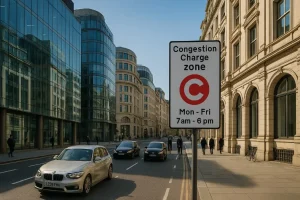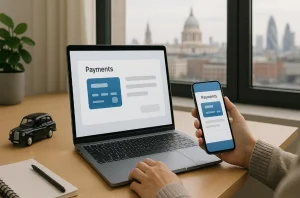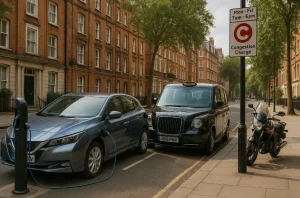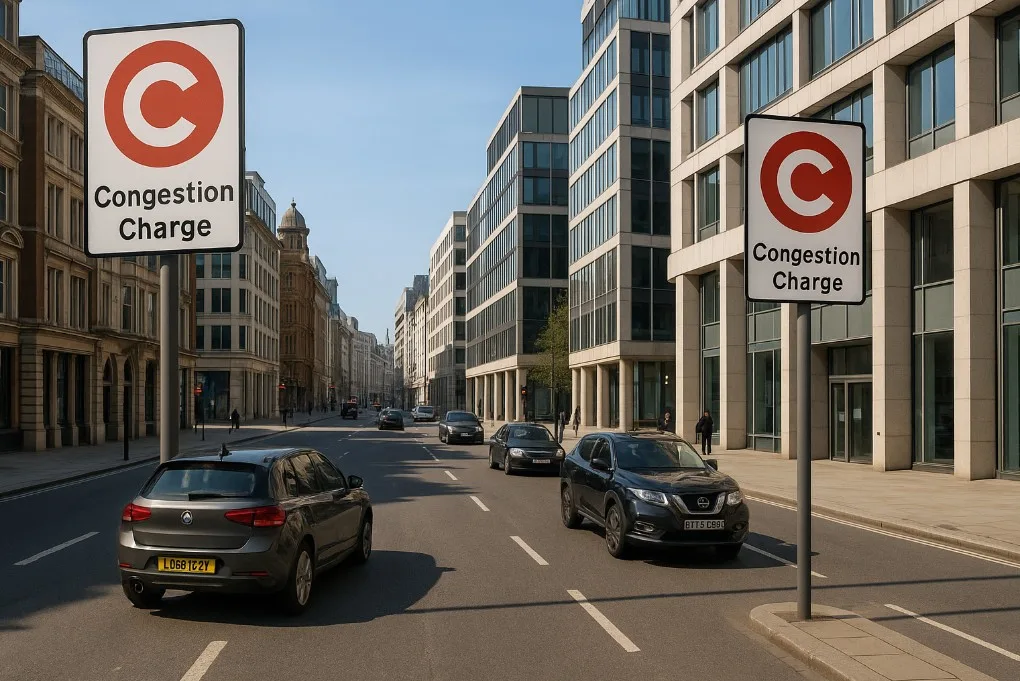Have you ever wondered why London drivers must pay a congestion charge to enter certain parts of the city? The scheme was first introduced in February 2003 as a bold move to reduce traffic levels in the heart of London. At the time, congestion in central London was at an all-time high, with delays costing businesses millions and causing frustration for commuters.
The purpose of the charge was not only to reduce the number of vehicles entering central London but also to improve air quality and encourage the use of public transport. Since its introduction, the scheme has gone through multiple consultations and revisions.
Over time, Transport for London (TfL) has adjusted the fees, reduced the operating hours, and added a range of discounts and exemptions to make the system more balanced.
What Exactly Is the Congestion Charge?

The congestion charge is a daily fee that applies to vehicles driving into or out of the Congestion Charging Zone (CCZ) in central London. The charge is fixed per day, which means that once the payment is made, drivers can enter and exit the zone as many times as needed during that day without paying extra.
At present, the standard fee is £15 per day if paid on time. If a driver delays payment beyond the initial period, the fee increases to £17.50. It is important to note that this charge is separate from other schemes such as the Ultra Low Emission Zone (ULEZ) or the Low Emission Zone (LEZ).
For example, a diesel car that does not meet emissions standards may be liable for both the congestion charge and the ULEZ charge if driven into central London on the same day.
When Does the Congestion Charge Apply?
The congestion charge is not applicable 24 hours a day but only during set operating hours.
From Monday to Friday, the charge applies from 07:00 to 18:00. On weekends and bank holidays, the timings are slightly shorter, running from 12:00 to 18:00. Drivers benefit from a complete exemption from 25 December through to 1 January each year.
This means that someone driving into Oxford Street at 19:30 on a Wednesday will not be charged, while another person entering at 08:00 on the same day must pay the daily fee.
Which Parts of London Fall Within the Congestion Charge Zone?
The Congestion Charging Zone covers much of central London within the Inner Ring Road. Drivers can recognise the boundaries by looking for road signs displaying a white letter “C” inside a red circle. In some areas, the symbol is painted directly on the road surface.
For those uncertain about whether their journey enters the zone, TfL provides a postcode and street name checker on its website. By entering a location, such as Trafalgar Square or Waterloo Bridge, drivers can see instantly whether it lies inside the charging zone. TfL also provides an interactive map which is updated as boundaries are revised.
How Much Does the Congestion Charge Cost?

The fee depends on when payment is made and whether deadlines are met.
| Payment time | Fee |
| Advance or same day (by midnight) | £15 |
| Up to midnight of the third day after entering the zone | £17.50 |
| Penalty Charge Notice (PCN) | £180 (reduced to £90 if paid within 14 days) |
For example, a driver entering the congestion zone on Monday but only remembering to pay on Wednesday night will be charged £17.50 rather than £15. If the payment is missed entirely, the driver receives a penalty notice which is much higher than the standard fee.
How Can Someone Pay Congestion Charge by Number Plate?
TfL has made the process of paying the congestion charge straightforward. The entire system is linked to vehicle registration numbers, which are captured by Automatic Number Plate Recognition (ANPR) cameras positioned throughout the city. Once a vehicle enters the zone, its number plate is cross-checked against TfL’s payment records.
There are three main ways to pay:
- Online: Drivers can make a payment directly on the official TfL website by creating a “London Road User Charging Account”. This allows one-off payments or the option to register for Auto Pay.
- App: The “Pay to Drive in London” app is available on both Android and iOS. It allows one-off payments, displays maps of the congestion charge zone, and checks whether a vehicle is compliant with ULEZ rules.
- Phone: Payments can also be made by calling TfL. For UK calls, the number is 0343 222 2222. International drivers can call +44 343 222 2222, and textphone users can call 020 7649 9123. Phone lines are open Monday to Friday between 08:00 and 20:00, excluding bank holidays.
What Is Auto Pay and Why Is It Useful?

Auto Pay is designed for those who drive into central London regularly. Instead of manually paying each time, drivers register their number plate with TfL. The system automatically charges their account whenever the vehicle enters the zone.
Up to five vehicles can be registered under one account, which makes it particularly useful for families and small businesses. For example, a delivery company operating three vans across central London would find Auto Pay more efficient than paying individually each day.
This method also reduces the risk of forgetting to pay and receiving a penalty charge notice.
What Happens If the Congestion Charge Is Not Paid?
Failing to pay the congestion charge results in a Penalty Charge Notice (PCN) being issued to the vehicle owner. The penalty is £180, reduced to £90 if paid within 14 days. If no payment is made within 28 days, the penalty increases to £270.
Drivers can pay the penalty online, through the TfL app, or by phone. There is also an appeals process for those who believe the fine has been wrongly issued, for instance, if a vehicle was exempt or had already been paid for.
Who Is Exempt from Paying the Congestion Charge?
Certain vehicles are completely exempt from the charge. These include:
- Motorbikes, mopeds, and tricycles
- Emergency vehicles such as ambulances, fire engines, and police cars
- Licensed London taxis
- Wheelchair-accessible private hire vehicles
- NHS vehicles that are exempt from vehicle excise duty
- Vehicles used by the armed forces and recognised breakdown services
If a vehicle falls into one of these categories, its number plate will not trigger a payment requirement in the system.
Who Can Apply for Discounts on the Congestion Charge?

Not all drivers are required to pay the full fee. TfL offers a range of discounts for eligible individuals and groups.
Residents living within the congestion charge zone can apply for a 90% discount, making it far more affordable for those who live and work in central London. Blue Badge holders can qualify for a 100% discount, ensuring accessibility needs are fully considered.
Fully electric and hydrogen fuel cell vehicles are also exempt from the charge until at least 24 December 2025, reflecting London’s commitment to promoting greener transport. Additionally, vehicles with nine or more seats, certain breakdown recovery vehicles, and accredited organisations may also receive discounts.
How Do Congestion Charge and ULEZ Differ?
Although they are often confused, the Congestion Charge and the Ultra Low Emission Zone are separate schemes.
| Feature | Congestion Charge | ULEZ |
| Purpose | Reduce traffic congestion | Improve air quality |
| Introduced | 2003 | 2019 |
| Applies to | All vehicles | High-emission vehicles |
| Daily Fee | £15–£17.50 | £12.50 (cars and vans) |
| Area | Central London only | Wider London area |
| Hours | 07:00–18:00 (weekdays) / 12:00–18:00 (weekends) | 24/7 |
For instance, a modern petrol car entering central London may only pay the congestion charge, while an older diesel car may have to pay both the congestion charge and ULEZ fee.
What Support Is Available for NHS Staff, Charities, and Care Workers?
Certain groups may not fall under the usual discount or exemption categories but can still claim reimbursements. NHS patients and staff travelling for essential treatment, registered charities, local authorities, and domiciliary care workers may apply for partial or full refunds. This ensures that the scheme does not unfairly impact essential services.
Conclusion
Paying the congestion charge by number plate is now a seamless process, whether through TfL’s website, app, or telephone line. The scheme has evolved since its introduction in 2003, balancing the need to reduce traffic and pollution with discounts and exemptions for those who need them.
Drivers who plan journeys into central London must understand when the charge applies, how much it costs, and whether they are eligible for exemptions or discounts. By staying informed, they can avoid unnecessary fines while contributing to London’s efforts to improve air quality and reduce congestion.
FAQs
How can drivers check if their journey falls inside the congestion charge zone?
They can use the TfL online postcode checker or view the congestion charge map to confirm if their route crosses into the zone.
Is it possible to pay without creating an account?
Yes, one-off payments can be made online, via the app, or by phone without registering, although Auto Pay is more convenient for regular users.
What if the number plate is not recognised by the system?
If TfL’s system fails to match the vehicle, drivers should contact customer services immediately to resolve the issue and avoid penalties.
How long do drivers have to pay after entering the zone?
Payment must be made by midnight on the day of travel or by midnight of the third day afterwards at a higher fee.
Are electric vehicles permanently exempt from the congestion charge?
Currently, electric and hydrogen fuel cell vehicles are exempt until 24 December 2025. The policy may be reviewed in future.
Do tourists in rental cars need to pay the congestion charge?
Yes, rental cars are treated the same as private cars. Payment can be arranged by the driver directly or through the rental company.
Can congestion charge fines be appealed?
Yes, appeals can be submitted online if a driver believes the fine was issued unfairly. Supporting evidence will be required.




